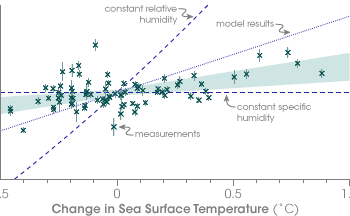NZCLIMATE TRUTH 43
19TH MARCH 2004
WATER VAPOUR
Water vapour is the most important greenhouse gas, a fact
which is concealed or covered up by politicians, environmentalists and scientists
alike. It is difficult to give a figure on how important since the infra
red absorption spectrum of water vapour overlaps that of carbon dioxide.
Figures I have been able to find range from 75 to 90% of the total greenhouse
effect coming from water vapour..
Apart from its role as vapour, water has a large influence
on the climate from its condensed forms, clouds and precipitation (rain
and snow), and on latent heat change, and change of albedo as it freezes..
You would think, then, that investigations on "climate change"
should place an emphasis on this overwhelmingly major influence.
Unfortunately, we have next to no reliable measurements
of atmospheric water vapour concentration and its variability with height,
region and other circumstances. We are making a start, but past information
is forever lost.
Climate change enthusiasts have therefore chosen to follow
the example of the man who looked under the lamp post for his lost wallet
because that was where the light was. They concentrate almost exclusively
on the minor greenhouse gases, such as carbon dioxide, methane abd ozone,
because we are able to measure them.
Climate models, based on the ridiculous assumption that
greenhouse gases are the only influence on the climate, are faced with the
problem of what to do with the major water vapour influence which they cannot
measure. They have decided to treat water vapour, and clouds as "feedbacks"
which can be assumed to bear a fixed mathematical relationship to the minor
greenhouse gases. Since these relationships cannot be tested they get away
with it easily, they can assume a large "positive feedback" and they
can leave water vapour and clouds out altogether when they present graphs
showing the various kinds of "radiative forcing"
A recent paper on the subject has been accepted
for the Journal "Climate Change"
Minschwaner, K., and A.E. Dessler, "Water vapor feedback in the
tropical upper troposphere: Model results and observations", Journal
of Climate March 15 2004
The preprint is available from <http://www.atmos.umd.edu/7Edessler/UTHfeedback.pdf>
This paper takes the satellite measurements of water vapour
concentration in the tropical upper troposphere from the Microwave
Limb Sounder (MLS) and HALogen Occultation Experiment (HALOE) which are instruments
located on the URAS satellite which was launched in late 1991. These measurements
were compared with Sea Surface Temperatures over the same period (attachment
WVapour.gif). This shows that the actual increases are well below those
assumed by the "constant humidity" assumption of all the computer
models.The above authors have provided an alternative
model of their own which, as shown by the dotted line (added by my correspondent,
Doug Hoyt) is not all that marvellous either.
Doug Hoyt comments that
these measurements deal with only one "feedback loop", and it is still
possible that the net "feedback" from water vapour could be negative, as
has been argued by Professor Lindzen, the subject of my last newsletter.

